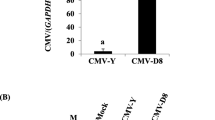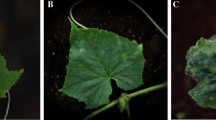Summary
I17F and R are subgroup I and II cucumber mosaic virus (CMV) strains, respectively. Whereas I17F induces severe symptoms on all hosts so far tested, R induces generally mild symptoms, except on Nicotiana glutinosa, on which it causes leaf blistering and severe stunting. Pseudorecombinants and recombinants, based on RNAs 1 and 2 from R-CMV, were created by adding either I17F RNA 3 or one of two chimeric RNAs created by exchanging approximate halves of RNA 3 of the two strains. The viruses created were tested on different hosts of the virus. On maize, local necrotic lesions were induced by all strains with the 5′ part of RNA 3 from R-CMV, whereas only I17F-CMV induced a systemic infection. The seven solanaceous hosts tested could be classified into two main groups. In the first, RNA 3 was not directly involved in the symptoms that were systemically induced, and the extreme disease severity induced by I17F was correlated with high virus accumulation. In the same hosts, the lesser virulence of R-CMV could reflect a deficiency in long-distance movement, involving RNA 3. The second group included Nicotiana glutinosa where the symptoms induced by R-CMV were determined by the 3′ part of RNA 3.
Similar content being viewed by others
Author information
Authors and Affiliations
Additional information
Accepted August 25, 1998 Received April 20, 1998
Rights and permissions
About this article
Cite this article
Carrère, I., Tepfer, M. & Jacquemond, M. Recombinants of cucumber mosaic virus (CMV): determinants of host range and symptomatology. Arch. Virol. 144, 365–379 (1999). https://doi.org/10.1007/s007050050510
Published:
Issue Date:
DOI: https://doi.org/10.1007/s007050050510




